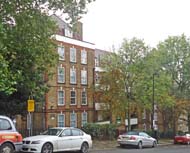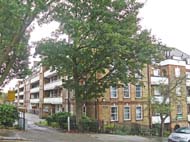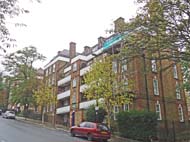King
Albert's Hospital for Convalescent Belgian Soldiers
No. 3
No. 3
Hazellville Road, Highgate, N19 3NB
Medical
dates:
Medical
character:
Convalescent (military)
The third King Albert's Hospital
opened on 8th February 1915 in Highgate, one of the highest parts of
London.
The Hospital consisted of a large central red brick building flanked by two pavilions on either side. The buildings had been erected in 1868 as the Alexandra Orphanage for Infants, but had been taken over in 1906 as an Additional Workhouse for the Shoreditch Poor Law Union.
The ground floor of the central building contained the Refectory and the Recreation Halls, as well as offices and store rooms. On its first floor were the chapel, which was served by a military chaplain, and living quarters for the staff. The basement was used for common purposes.
The Hospital had 300 beds. Patients were accommodated in the four flanking pavilions, according to the nature of their illness - those recovering from surgery, those with fever or with infectious disease, and those with lung disease, such as tuberculosis. As the Hospital was some 100 metres above sea-level, it was thought that the air would be beneficial for those with lung problems; mists rarely occurred and the buildings were very dry.
The ward pavilions each contained two bathrooms and one special bathroom for medical baths. Each pavilion has a treatment room reserved for the changing of dressings.
Patients suffered from a variety of afflictions - recent wounds (chiefly to hands, arms and shoulders), open septic wounds, every form of rheumatism from the wet trenches of the Belgian Front, atrophied nerves, adhesions, paralysis, varicose veins, phlebitis, synovitis, crushed feet, shell shock, nervous prostration or general debility. Several men had been dug up after being buried during shelling of the battlefield.
Although the Hospital had an X-ray apparatus, it was not strong enough for obscure cases, with many of the films underexposed. Patients were then sent to outside specialists for their radiographic examinations.
Separate from the four ward blocks was a Disinfection Room for clothes and bed linen. A Laboratory was established for microscopic and bacteriological investigations.
The medical staff consisted of a physician and a surgeon (a regular surgical service had been established in July 1915), while the nursing staff comprised the Matron (Mlle Pecher, from Antwerp) and 5 qualified nurses. Other personnel included 18 administrators and 20 domestics.
By 31st December some 896 patients had been admitted, of which 238 still remained in Hospital. Although no deaths had occurred, 14 patients had deserted.
On 12th November 1917 the Massage Department from the Belgian Convalescent Home at No. 14 Westbourne Terrace moved to the Hospital. It was staffed by 12 masseurs and 2 masseuses. The Hospital provided a room and two radiant heat machines. For the first two months the Department was largely ignored by the medical staff but, by March 1918, the situation had improved and patients steadily increased in number. From April to October 1918 the Massage Department opened an annexe at the Belgian Soldiers' Hostel at No. 44 Grosvenor Gardens, for patients who found the journey to the Hospital too far for regular attendance. Following the October advance, the Massage Department treated about 35 to 40 patients a day with massage, radiant heat and electrotherapy (galvanism, Faradism and ionisation).
The Hospital closed on 19th February 1919.
The Hospital consisted of a large central red brick building flanked by two pavilions on either side. The buildings had been erected in 1868 as the Alexandra Orphanage for Infants, but had been taken over in 1906 as an Additional Workhouse for the Shoreditch Poor Law Union.
The ground floor of the central building contained the Refectory and the Recreation Halls, as well as offices and store rooms. On its first floor were the chapel, which was served by a military chaplain, and living quarters for the staff. The basement was used for common purposes.
The Hospital had 300 beds. Patients were accommodated in the four flanking pavilions, according to the nature of their illness - those recovering from surgery, those with fever or with infectious disease, and those with lung disease, such as tuberculosis. As the Hospital was some 100 metres above sea-level, it was thought that the air would be beneficial for those with lung problems; mists rarely occurred and the buildings were very dry.
The ward pavilions each contained two bathrooms and one special bathroom for medical baths. Each pavilion has a treatment room reserved for the changing of dressings.
Patients suffered from a variety of afflictions - recent wounds (chiefly to hands, arms and shoulders), open septic wounds, every form of rheumatism from the wet trenches of the Belgian Front, atrophied nerves, adhesions, paralysis, varicose veins, phlebitis, synovitis, crushed feet, shell shock, nervous prostration or general debility. Several men had been dug up after being buried during shelling of the battlefield.
Although the Hospital had an X-ray apparatus, it was not strong enough for obscure cases, with many of the films underexposed. Patients were then sent to outside specialists for their radiographic examinations.
Separate from the four ward blocks was a Disinfection Room for clothes and bed linen. A Laboratory was established for microscopic and bacteriological investigations.
The medical staff consisted of a physician and a surgeon (a regular surgical service had been established in July 1915), while the nursing staff comprised the Matron (Mlle Pecher, from Antwerp) and 5 qualified nurses. Other personnel included 18 administrators and 20 domestics.
By 31st December some 896 patients had been admitted, of which 238 still remained in Hospital. Although no deaths had occurred, 14 patients had deserted.
On 12th November 1917 the Massage Department from the Belgian Convalescent Home at No. 14 Westbourne Terrace moved to the Hospital. It was staffed by 12 masseurs and 2 masseuses. The Hospital provided a room and two radiant heat machines. For the first two months the Department was largely ignored by the medical staff but, by March 1918, the situation had improved and patients steadily increased in number. From April to October 1918 the Massage Department opened an annexe at the Belgian Soldiers' Hostel at No. 44 Grosvenor Gardens, for patients who found the journey to the Hospital too far for regular attendance. Following the October advance, the Massage Department treated about 35 to 40 patients a day with massage, radiant heat and electrotherapy (galvanism, Faradism and ionisation).
The Hospital closed on 19th February 1919.
The buildings were demolished in the 1920s for the Hornsey Rise Estate, which was completed in 1928.


Three large council apartment blocks - Welby House, Goldie House and Ritchie House - now occupy the site of the Hospital (left). Goldie House, the central block, takes up much of the site (right).

Looking northward along the frontage of the Hornsey Rise Estate in Hazellville Road.
(Author unstated) (Undated) Photograph of patients at the Hospital. Document BEL 10 1/8 Women at Work Collection, Imperial War Museum, London.
May P 1915 King Albert's Hospitals. Rapport de l'Exercice 1914-1915 [in French]. Document BEL 10 1/7 Women at Work Collection, Imperial War Museum, London.
Pardoe M 1917 Correspondence giving further information about King Albert's Hospitals. Document BEL 10 1/4 Women at Work Collection, Imperial War Museum, London.
http://newspapers.nl.sg
http://uurl.bkr.be
www.1914-1918.be (1)
www.1914-1918.be (2)
www.1914-1918.be (3)
www.rootschat.com
Return to alphabetical list
Return to home page